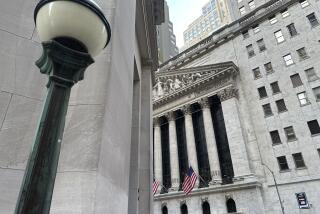Do Yield Declines Invite a Reality Check for Bonds?
- Share via
Talking about worrisome speculation and sky-high valuations in the U.S. stock market is old hat by now, so as Bob Dole would say, “Let’s just don’t do it.”
Instead, let’s talk about worrisome speculation and sky-high valuations in the world bond market.
On Tuesday, long-term U.S. Treasury bond yields fell again to fresh seven-month lows, which traders attributed to growing belief in a moderating economy and confidence that the election would maintain the status quo in Washington.
But the U.S. Treasury market is a piker compared with other bond markets on the planet, including the U.S. corporate bond arena. The yield declines in many countries this year--or at least the declines relative to yields on Treasury issues, supposedly the world’s safest credits--are being variously described as wondrous, puzzling, frightening and absurd.
Consider: In Japan, government bond yields have been hitting record lows almost every day of the past few weeks, as investors have rushed to lock in returns before they go even lower. And what do you earn on a 10-year Japanese government bond now? A big annual yield of 2.42%.
In Italy, which had one of the higher-yielding government bond markets among developed countries earlier this year, buyers have been so hungry in recent months that Italian 10-year bond yields have plunged to 7.88% now from 11% in March.
And in Canada, little Canada, 10-year government bonds now yield 6.15%--below what Uncle Sam has to pay.
*
Yet the yield slide in those global markets doesn’t seem nearly as wacky to veteran bond-market analysts as what has happened with yields on U.S. corporate bonds.
Some of America’s better companies are paying not much more than the Treasury to borrow in the bond market these days. CIT Group Holdings, a finance company, on Tuesday sold two-year notes yielding 5.90%, barely above the 5.72% yield on two-year Treasury notes.
And the Federal Home Loan Mortgage Corp., a government-chartered but shareholder-owned mortgage finance company, recently borrowed at a yield just 0.01 point above comparable Treasury securities, says Gerald Guild, chief bond trader at Advest Group in Hartford, Conn. “I am mystified,” Guild says. In market jargon, there is supposed to be a “spread” between super-safe Treasury yields and other yields. “The spreads today certainly are too narrow for me,” Guild says.
William Gross, chief bond strategist at Newport Beach-based Pacific Investment Management Co.--one of the world’s biggest bond investors--has another description for today’s corporate bond yields. “They’re ridiculous,” he says. “You’d have to be a fool to accept them.”
Gross’ concern may seem old-fashioned, but it’s about risk versus return. The market, he and other veteran bond players say, has seemingly forgotten that bad things can happen to companies and their finances, especially when recessions hit. Unlike the Treasury, companies can’t print money to cover their debts. They have to earn it. Thus, the yields that investors accept on money lent to those companies should reflect that--the chance of something going wrong, because someday it will.
In the case of other governments, the narrowing spread between their bond yields and Uncle Sam’s is perhaps more defensible. Other governments, like ours, can print money. And if those governments do a better job of restraining inflation and thus protecting their currencies’ values, it makes sense that bond investors should reward them by accepting lower yields.
So then what, exactly, is the global bond market saying these days? Jim Grant of Grant’s Interest Rate Observer newsletter in New York offers one sobering idea: Canada’s ability to borrow at a lower rate than America constitutes a de facto, if painless, credit-rating downgrade for America.
In the big picture, plunging bond yields may suggest one of two things: a speculative mania which, the crazier it gets, could be quickly and painfully reversed (as with the small-stock mania of spring); or, that the global economy is much weaker than most experts believe, and will get even weaker in 1997, bringing with it lower inflation worldwide or even deflation.
The big problem with both of those scenarios is that neither would bode well for stocks.
(BEGIN TEXT OF INFOBOX / INFOGRAPHIC)
Squeezing the Spread
The difference between U.S. Treasury bond yields and yields on other countries’ bonds has narrowed dramatically this year. Yields on 10-year bonds of Italy, Canada and the United States, monthly closes and Tuesday:
Italy: 7.88%
Canada: 6.27%
U.S.: 6.15%
Source: Bloomberg Business News
More to Read
Inside the business of entertainment
The Wide Shot brings you news, analysis and insights on everything from streaming wars to production — and what it all means for the future.
You may occasionally receive promotional content from the Los Angeles Times.










